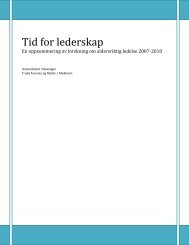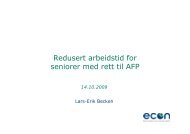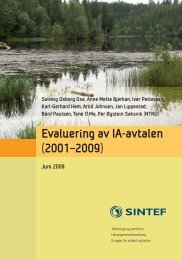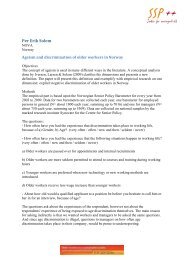Professor Philip Taylor - Older workers in a sustainable society ...
Professor Philip Taylor - Older workers in a sustainable society ...
Professor Philip Taylor - Older workers in a sustainable society ...
You also want an ePaper? Increase the reach of your titles
YUMPU automatically turns print PDFs into web optimized ePapers that Google loves.
www.monash.edu<br />
Def<strong>in</strong><strong>in</strong>g public policy for older<br />
<strong>workers</strong>: An ill-def<strong>in</strong>ed group<br />
<strong>Professor</strong> <strong>Philip</strong> <strong>Taylor</strong><br />
Director of Research and Graduate Studies,<br />
Monash University, Gippsland Campus<br />
<strong>Older</strong> Workers <strong>in</strong> a Susta<strong>in</strong>able<br />
Society<br />
Oslo<br />
June 2010<br />
www.monash.edu
www.monash.edu<br />
Content<br />
• Exam<strong>in</strong>es changes <strong>in</strong> work and retirement aga<strong>in</strong>st a<br />
background of population age<strong>in</strong>g.<br />
• Reviews the status of policymak<strong>in</strong>g concerned with age<br />
and employment and how this needs to be adapted to<br />
align with the needs of different <strong>in</strong>dividuals and societies.<br />
• Considers trends <strong>in</strong> the employment of older <strong>workers</strong>, how<br />
policymakers are envision<strong>in</strong>g a flexible end to work<strong>in</strong>g life<br />
and their prospects of success.
www.monash.edu<br />
<strong>Older</strong> <strong>workers</strong> <strong>in</strong> context<br />
• To understand the present situation of older <strong>workers</strong> some<br />
context is required.<br />
• Policy development s<strong>in</strong>ce the late-1990s has been the of<br />
prolongation of work<strong>in</strong>g lives, presented as a means of<br />
reduc<strong>in</strong>g pressures on social welfare systems.<br />
• Contrasts with previous approaches which focused on the<br />
need to remove older <strong>workers</strong> from the labour market <strong>in</strong><br />
response to high unemployment.<br />
• In the 1980s and 1990s the restructur<strong>in</strong>g of <strong>in</strong>dustrialised<br />
economies was accompanied by a dramatic fall <strong>in</strong> labour<br />
force participation among older <strong>workers</strong>.
www.monash.edu<br />
The labour market and older <strong>workers</strong><br />
• Research po<strong>in</strong>ts to the disadvantaged status of older <strong>workers</strong><br />
<strong>in</strong> the labour markets of the <strong>in</strong>dustrialised economies. Their<br />
position is summarised <strong>in</strong> a review of OECD countries:<br />
– Labour market mobility <strong>in</strong> terms of new hires is lower for older<br />
<strong>workers</strong>.<br />
– While rates of job loss are similar for younger and older <strong>workers</strong>,<br />
the latter are more prone to experience long-term unemployment.<br />
– A shift to economic <strong>in</strong>activity is generally permanent across older<br />
age groups (OECD 2006).<br />
• On the other hand, after decades of <strong>in</strong>creas<strong>in</strong>gly early labour<br />
market withdrawal, important changes have been underway.
www.monash.edu<br />
Employment/population ratios, men and<br />
women aged 55-64, 1979-2008<br />
Men<br />
Women<br />
1979 1983 1990 1995 2000 2008 1979 1983 1990 1995 2000 2008<br />
Australia 67.4 59.6 59.2 55.3 58.3 65.7 19.8 19.9 24.2 27.4 35.3 49.1<br />
F<strong>in</strong>land 54.3 51.4 46.3 34.9 43.7 57 39.0 44.1 39.7 33.1 40.9 55.8<br />
Germany 63.2 57.4 52.0 47.2 46.4 61.7 26.8 24.0 22.4 24.4 29.0 46<br />
Netherlands 63.2 46.1 44.5 39.9 49.9 60.2 14.0 13.2 15.8 18.0 25.8 41.1<br />
Japan 81.5 80.5 80.4 80.8 78.4 81.4 44.8 45.1 46.5 47.5 47.9 51.7<br />
UK - 64.3 62.4 56.1 59.8 67.7 - - 36.7 39.3 41.4 49<br />
USA 70.8 65.2 65.2 63.6 65.7 67.7 40.4 39.4 44.0 47.5 50.6 57<br />
EU-15 - - 52.3 47.2 48.9 56 - - 24.3 25.6 28.4 38.9<br />
Source: OECD Employment Outlook (various)
www.monash.edu<br />
New consensus on ‘active age<strong>in</strong>g’<br />
• Emerg<strong>in</strong>g consensus around the notion of ‘active age<strong>in</strong>g’,<br />
def<strong>in</strong>ed by the WHO (2002) as ‘the process of optimiz<strong>in</strong>g<br />
opportunities for health, participation and security <strong>in</strong> order to<br />
enhance quality of life as people age’.<br />
• Accord<strong>in</strong>g to the OECD (1998), this requires:<br />
‣ emphasis<strong>in</strong>g prevention, mak<strong>in</strong>g policy <strong>in</strong>terventions at an<br />
earlier life stage, reduc<strong>in</strong>g the need for later remedial action<br />
‣ less fragmented actions, concentrated at critical transition<br />
po<strong>in</strong>ts <strong>in</strong> life<br />
‣ and enabl<strong>in</strong>g less constra<strong>in</strong>ed choices and greater<br />
responsibility at the level of <strong>in</strong>dividuals.
The Times, 12 May 2006, p.28
www.monash.edu<br />
Life course perspectives on work<strong>in</strong>g longer<br />
www.monash.edu
www.monash.edu<br />
The Life Course Perspective<br />
Fundamental pr<strong>in</strong>ciples characterize the life course approach:<br />
1. socio-historical and geographical context<br />
2. tim<strong>in</strong>g of lives<br />
3. heterogeneity or variability<br />
4. ‘l<strong>in</strong>ked lives’ and social ties to others<br />
5. human agency and personal control and<br />
6. how the past shapes the future.
www.monash.edu<br />
Socio-historical and geographical context<br />
• Individual developmental pathways embedded <strong>in</strong> and<br />
transformed by conditions and events occurr<strong>in</strong>g dur<strong>in</strong>g the<br />
historical period and their geographical location e.g.<br />
geopolitical events, economic cycles, and social and cultural<br />
ideologies shape perceptions and choices.
www.monash.edu<br />
Tim<strong>in</strong>g of lives<br />
3 types: <strong>in</strong>dividual, generational, and historical<br />
• Individual time - periods of life, such as childhood, adolescence, and old<br />
age, and access to roles and rights <strong>in</strong> <strong>society</strong>; based on culturally shared<br />
def<strong>in</strong>itions.<br />
• Generational time - age groups or cohorts, based upon their age e.g. baby<br />
boom generation.<br />
• Historical time - societal or large-scale changes or events and how these<br />
affect <strong>in</strong>dividuals and families e.g. political and economic changes, war<br />
and technological <strong>in</strong>novation.
www.monash.edu<br />
Heterogeneity or variability<br />
• Recognition of not only modal or average developmental and transitional<br />
trends, but also variability.<br />
• Generations or cohorts not homogeneous, differ on critical dimensions<br />
e.g. gender, social-economic group, family structure, ethnicity.<br />
• Ability to adapt to life course events varies with the resources or supports<br />
<strong>in</strong>herent <strong>in</strong> these elements <strong>in</strong> the form of economic or cultural capital (e.g.<br />
wealth, education) or social capital (e.g. family social support).<br />
• Increas<strong>in</strong>g variability associated with age<strong>in</strong>g. Longer lives br<strong>in</strong>g with them<br />
greater exposure to factors that affect the age<strong>in</strong>g process.
www.monash.edu<br />
L<strong>in</strong>ked lives and social ties<br />
• Lives are <strong>in</strong>terdependent and reciprocally connected on different<br />
levels. Societal and <strong>in</strong>dividual experiences l<strong>in</strong>ked thorough family and<br />
networks of shared relationships.<br />
• As a result, macro-level events e.g. economic recession, could affect<br />
<strong>in</strong>dividual behaviours (e.g. forced to rema<strong>in</strong> economically active), and<br />
this can significantly affect other familial relationships e.g. car<strong>in</strong>g<br />
responsibilities.
www.monash.edu<br />
Human agency and personal control<br />
• Individuals are active agents who not only mediate the effect of social<br />
structures but also make decisions and set goals that shape their<br />
biographies.<br />
• Have the capacity to engage <strong>in</strong> planful competence, the thoughtful,<br />
proactive, and self-controlled processes that underlie choices about<br />
<strong>in</strong>stitutional <strong>in</strong>volvements and social relationships.<br />
• But, choices are <strong>in</strong>fluenced by opportunities and constra<strong>in</strong>ts.<br />
• And <strong>in</strong>dividuals modify their expectations and behaviour <strong>in</strong> response to<br />
changes <strong>in</strong> either needs or resources.
www.monash.edu<br />
The past shapes the future<br />
• Life course choices, opportunities, and conditions affect later outcomes<br />
which can be envisioned as ripple or dom<strong>in</strong>o effects.<br />
• Occur at the cohort/generational level and the <strong>in</strong>dividual/familial level e.g.<br />
one generation can transmit to the next the reverberations of the historical<br />
circumstances that shaped its history (e.g. experienc<strong>in</strong>g recession).<br />
• Tim<strong>in</strong>g and conditions of life events and behaviours occur (e.g. job loss,<br />
occupational <strong>in</strong>jury) can set up a cha<strong>in</strong> reaction of experiences for<br />
<strong>in</strong>dividuals and their families (e.g. reproduction of poverty).<br />
• Thus, the past can significantly affect later life outcomes and recognis<strong>in</strong>g the<br />
role of cumulative advantage or disadvantage is valuable <strong>in</strong> consider<strong>in</strong>g<br />
policymak<strong>in</strong>g.
www.monash.edu<br />
Consider<strong>in</strong>g the life course from an labour<br />
market perspective<br />
• Destandardisation of transitions from school to old age.<br />
• Chang<strong>in</strong>g skill demands and greater emphasis on ‘employability’.<br />
• Labour market deregulation :<br />
‣Decorporatisation of <strong>in</strong>dustrial relations.<br />
‣Volatile labour market dynamics.<br />
‣Core/periphery employment and the casualisation of work.<br />
‣Internal labour markets versus contractual work.<br />
• Chang<strong>in</strong>g <strong>in</strong>stitutional frameworks.<br />
www.monash.edu
www.monash.edu<br />
New policies for older <strong>workers</strong><br />
Policy measures <strong>in</strong>clude:<br />
– Closure of or limits on use of early retirement pathways<br />
– Increas<strong>in</strong>g retirement ages<br />
– ‘Active’ labour market measures<br />
– Rewards for pension deferral<br />
– End<strong>in</strong>g mandatory retirement<br />
– More flexible approach to retirement e.g. gradual retirement.<br />
But, mixed evidence on the success of the various measures e.g.<br />
– End<strong>in</strong>g mandatory retirement appears not to have been effective.<br />
– Gradual retirement schemes appear to have had limited <strong>in</strong>fluence,<br />
although early days <strong>in</strong> terms of evaluation.<br />
– Gradual retirement schemes may even have promoted early retirement.<br />
– Evidence of cream<strong>in</strong>g, deadweight effects and occupational<br />
downshift<strong>in</strong>g.
www.monash.edu<br />
Flexible retirement or <strong>in</strong>flexible work<strong>in</strong>g<br />
• Surveys f<strong>in</strong>d that older <strong>workers</strong> are will<strong>in</strong>g to work on if they<br />
can reduce or work flexible hours.<br />
• But what are the realities of flexible work<strong>in</strong>g<br />
• Flexibility may benefit some, but for others a gradual switch<br />
from work to non-work is not an option.<br />
• Data suggestive of significant constra<strong>in</strong>ts on older <strong>workers</strong>’<br />
choices.<br />
• S<strong>in</strong>gular public policy position of one-way transitions from<br />
full-time to part-time work and on to retirement is misguided,<br />
perhaps driven by ageist assumptions.
Source: Bureau of Labor Statistics<br />
www.monash.edu
Source: Bureau of Labor Statistics<br />
www.monash.edu
Percent<br />
February<br />
Quarter 1978<br />
February<br />
Quarter 1983<br />
February<br />
Quarter 1988<br />
February<br />
Quarter 1993<br />
February<br />
Quarter 1998<br />
February<br />
Quarter 2003<br />
February<br />
Quarter 2008<br />
www.monash.edu<br />
Underemployment Rates: Australia<br />
Males by Age<br />
Source: Australian Bureau of Statistics<br />
14<br />
12<br />
10<br />
8<br />
6<br />
4<br />
2<br />
0<br />
M 15 - 24<br />
M 25 - 34<br />
M 35 - 44<br />
M 45 - 54<br />
M 55 and over<br />
Quarter / Year
Percent<br />
February<br />
Quarter 1978<br />
February<br />
Quarter 1983<br />
February<br />
Quarter 1988<br />
February<br />
Quarter 1993<br />
February<br />
Quarter 1998<br />
February<br />
Quarter 2003<br />
February<br />
Quarter 2008<br />
www.monash.edu<br />
Underemployment Rates: Australia<br />
Females by Age<br />
Source: Australian Bureau of Statistics<br />
18<br />
16<br />
14<br />
12<br />
10<br />
8<br />
6<br />
15 - 24<br />
25 - 34<br />
35 - 44<br />
45 - 54<br />
55 and over<br />
4<br />
2<br />
0<br />
Quarter / Year
Percent<br />
www.monash.edu<br />
45<br />
40<br />
35<br />
30<br />
25<br />
20<br />
15<br />
10<br />
5<br />
1 to 12 Weeks<br />
13 to 51 Weeks<br />
52 Weeks and Over<br />
0<br />
15 - 19 20 - 24 25 - 34 35 - 44 45 - 54 55 years<br />
and over<br />
Age Group / Duration of Underemployment<br />
Australian Underemployment Rates by Duration. Men by Age (Australian<br />
Bureau of Statistics)<br />
23
Percent<br />
www.monash.edu<br />
60<br />
50<br />
40<br />
30<br />
20<br />
1 to 12 Weeks<br />
13 to 51 Weeks<br />
52 Weeks and Over<br />
10<br />
0<br />
15 - 19 20 - 24 25 - 34 35 - 44 45 - 54 55 years<br />
and over<br />
Age Group / Duration of Underemployment<br />
Australian Underemployment Rates by Duration. Women by Age (Australian<br />
Bureau of Statistics)<br />
24
www.monash.edu<br />
Summary<br />
• Policymak<strong>in</strong>g has had a s<strong>in</strong>gular focus on delay<strong>in</strong>g<br />
retirement, ignor<strong>in</strong>g the the diversity of older people’s<br />
lived lives.<br />
• Narrow economic imperatives are overrid<strong>in</strong>g wider<br />
social ones such as the work/care nexus.<br />
• Neglect of such scenarios risks expos<strong>in</strong>g older<br />
people to the now familiar problem of dim<strong>in</strong>ish<strong>in</strong>g<br />
opportunities and <strong>in</strong>creas<strong>in</strong>g constra<strong>in</strong>ts and with<br />
them, reduced prospects for ‘active age<strong>in</strong>g’.<br />
www.monash.edu
www.monash.edu<br />
New policies for older <strong>workers</strong><br />
• Realistic stance on older <strong>workers</strong>’ employment<br />
– Extend<strong>in</strong>g work<strong>in</strong>g lives depends on a range of <strong>in</strong>dividual,<br />
organisational, economic and societal factors and while<br />
this may be achievable for some, for others it might be<br />
remote.<br />
• Integrated and strategic policymak<strong>in</strong>g<br />
– Need for a matrix of public policies which respond to the<br />
heterogeneity of older people’s lives, not devise policy<br />
accord<strong>in</strong>g to chronological age.<br />
• Preventative<br />
– A shift to a life course approach, emphasis<strong>in</strong>g long-term<br />
measures.
www.monash.edu<br />
Summary<br />
• Integrated and strategic approaches aim<strong>in</strong>g to produce susta<strong>in</strong>able<br />
workforces and which move beyond a static view of older <strong>workers</strong> will:<br />
‣ Support a diverse workforce to balance work and non-work<br />
obligations.<br />
‣ Be sensitive to the need to empower <strong>workers</strong> to rema<strong>in</strong> competitive<br />
over the long-term.<br />
‣ Challenge age-based and other stereotypes, not reflect them.<br />
‣ Accept that some <strong>workers</strong>’ lifecourse trajectories leave them illequipped<br />
to compete <strong>in</strong> a modern economy.<br />
‣ Take the long view, plann<strong>in</strong>g for the older workforce of the future.<br />
www.monash.edu
www.monash.edu<br />
Thank you<br />
<strong>Philip</strong>.taylor@adm.monash.edu.<br />
au<br />
www.monash.edu
















